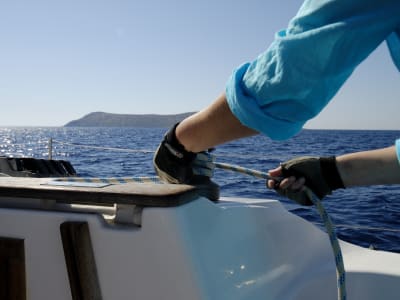Get your ICC and skipper your own yacht.
Overview
The International Certificate of Competence (ICC) is a test of competence that provides the student with an internationally recognized qualification.
The ICC, or higher certification, is required in both Croatia and Greece and other countries, particularly in Europe, where governments are increasingly looking for recognizing certificates to confirm the student reaches an internationally agreed level of competence.
Students with previous skippering experience can be assessed for ICC eligibility at our Port Solent, UK base. The purpose is to provide documentary assurance from one government to another that the holder meets an agreed level of competence.
Those with limited skippering experience can complete the five-day ICC course (at Port Solent) which culminates in the assessment.
Highlights
- Internationally recognized Certificate of Competence
- Allows the holder to sail in countries where formal qualifications are compulsory
- One-day assessment and exam
- ICC/RYA Day Skipper required for sailing in Greece, Croatia and Turkey
We recommend
Taking the Essential Navigation and Seamanship (ENAS) online course prior to your ICC Assessment. This ENAS online course will give you the essential knowledge needed when you’re afloat, from navigation to safety and seamanship to passage planning.
PLEASE NOTE: The ICC cannot be issued to applicants who are from a country who has signed Resolution 40. For a list of ineligible countries please click here.
Where to take this course with Sunsail
Why take this course with Sunsail?
The International Certificate of Competence Assessment is an internationally recognized certificate that enables the holder to sail in countries where formal qualifications are compulsory.
As many countries now require visiting yachtsmen to hold formal qualifications, the ICC provides documentary assurance from one government to another that the holder meets an agreed level of competence. The ICC is a test of competence, it is not a qualification.
If you have attended an RYA practical training course, presenting your certificate with your ICC application form may be sufficient, or you can take the one-day exam from our base in Port Solent, UK.
Most EU Nationals are eligible to apply for the ICC but please note that The ICC cannot be issued to applicants who are from a country who has signed Resolution 40. For a list of ineligible countries please click here.
Course syllabus
Short passage
Departing a pontoon
- Communication with crew
- Use of springs
- Fender positioning
- Man overboard (MOB) procedures
- Correct direction and speed of approach
- Contact with MOB
Alongside skills
- Communication with crew
- Awareness of other water users
- Use of warps/fenders
- Correct angle and speed of approach
- Securing boat to pontoon
360-degree turn
- How to do a 360-degree turn
Securing to a buoy
- Communication with crew
- Preparing warp
- Correct angle and speed of approach
- Securing the boat effectively
- Departing from the buoy safely
Handling under sail
- Choosing suitable sails for prevailing conditions
- Choosing a suitable area for hoisting/lowering sails
- Trimming sails correctly
- Communicating with crew before undertaking any maneuvers
- Undertaking a check of the area before tacking and gibing
Power manoeuvres
- Awareness for other water users
- Use of a kill-cord
- Choosing a suitable area to carry out maneuvers
- Carrying out an emergency stop
- Able to control speed on turns and warning crew before starting and executing emergency turns
Theory test
Regulations
- Able to recognize a potential collision situation
- Able to recognize action to take as “stand on” and “give way” vessel
- Able to determine a safe speed
- Able to recognize maneuvering signals
- Able to recognize and make visual distress signals
- Able to keep a proper lookout
Regulations and Pilotage
- Able to understand requirements for navigation lights and ships
- Able to recognize sound signals
- Able to recognize the following from the lights – vessel at anchor, power-driven vessel and sailing vessel
- Able to recognize, by day and night, and understand the significance of buoys of the IALA system
- Able to plan a harbor entry/departure, taking in to account possible hazards
- Aware of the sources of information regarding local regulations, port entry and departure signals and Port Operations radio
Navigation
- Able to plot a position by cross bearings and by Latitude and Longitude
- Able to interpret a navigational chart and understand charted depths, drying heights and charted hazards
- Able to use a tide table to find times and heights of high and low water
- Able to determine direction and rate of tidal stream from a tidal atlas or from tidal diamonds
- Able to determine magnetic course to steer, making allowances for leeway and tidal stream
There is currently no requirement to have completed a specific course covering the above and completion of any good all round basic tidal navigation and seamanship theory course should be sufficient.
Step Aboard Here
Start your experience with Sunsail on land and sign up to receive e-mails from us about yachts, offers and destinations.
By clicking 'Sign up' you confirm that you have read and understood our Privacy Policy and consent to our use of your information.
